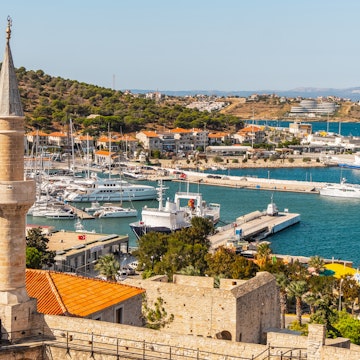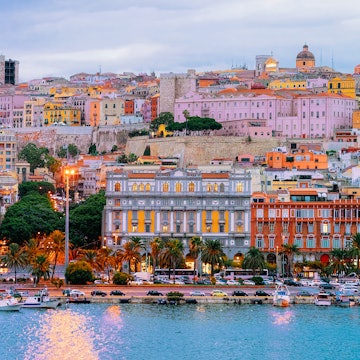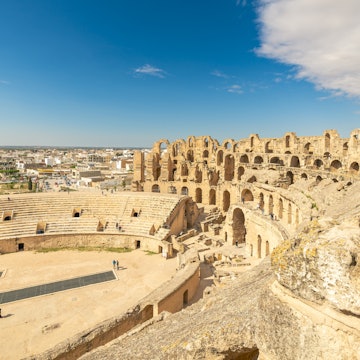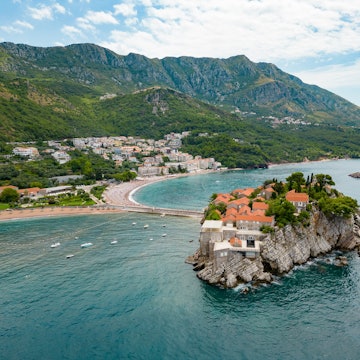

Sidi Bou Saïd, Tunisia. KrzysztofG/Getty Images
Perched atop a steep-sided promontory overlooking the azure Gulf of Tunis, Sidi Bou Saïd, named after a 13th-century Sufi scholar, is a charming little suburb slowly being enveloped by Tunisia’s capital, Tunis. Its namesake mosque lies at its core, and a chic simplicity cultivates a genteel atmosphere. Gleaming white homes, draped in magenta bougainvillea, line the cobblestone streets, each one lent uniformity and character by its royal blue window frames, shutters and doors that are studded with black pins.
This harmonic aesthetic has made Sidi Bou Saïd internationally popular; luminaries such as the French philosopher Michel Foucault, German artist Paul Klee and Tunisian fashion designer Azzedine Alaïa once called the town home.
Unsurprisingly, Sidi Bou Saïd’s singularly photogenic style can sometimes turn it into an Instagram-era honeypot. But plan your visit well and you can sidestep the crowds and experience what all the fuss is about in relative peace. Discover how with this handy guide for first-time visitors.

When should I go to Sidi Bou Saïd?
This classic question comes with no hard and fast answers. Let’s break it down into season and time. The shoulder seasons of spring and autumn are by far the best times to visit Sidi Bou Saïd in terms of weather: sunny days, a reduced chance of rainfall and warm evenings. These months also allow you to avoid the teeming crowds that clog Sidi Bou Saïd’s streets in summer, although busloads of tourists do descend on the neighborhood year-round, even during winter.
Timing is trickier to plan. The neighborhood is generally busiest in the afternoon, as people gather at the viewpoints for sunset. However, given the town’s east-facing location, sunrise is more spectacular than sunset. Staying overnight, visiting in the morning before 11am or arriving later in the evening are recommended if you prefer to avoid the densest crowds.
Unless you’re fasting yourself, try to avoid visiting during the holy month of Ramadan (dates change every year), when all food vendors, from street stalls to high-end restaurants, are closed during the daytime. If you do visit during Ramadan, embrace the iftar (the postsunset communal meal that signifies the breaking of the day’s fast).
How much time should I spend in Sidi Bou Saïd?
You can soak in the atmosphere and see much of Sidi Bou Saïd in a couple of hours just by ambling around the streets in the upper part of the neighborhood. If you plan to walk down to the marina or visit one of the galleries, allow at least half a day. Some people give themselves a little longer by staying overnight, which is ideal for experiencing Sidi Bou Saïd at sunrise and without the daytime crowds.

Is it easy to get in and around Sidi Bou Saïd?
Suburban TGM trains run from Tunis and La Marsa to Sidi Bou Saïd station, which is located half a kilometer (one-third of a mile) from the heart of the town. During rush hour, trains run roughly every 15 minutes and can get quite crowded.
The suburb is relatively small and, while far from flat, easy enough for most people to navigate on foot. It can be loosely divided into two halves: the upper neighborhood (where most of the main sights are located) and the marina area. This lower region, with its beach, is best reached on foot via a worn staircase called the 365 Steps, although in reality there are about 100 fewer than that.
Most of the upper neighborhood’s streets are blocked off to vehicles, however, you can get a taxi right to the foot of the main thoroughfare, Rue Hedi Zarrouk, where it meets Rue du 2 Mars 1934. Rideshare apps such as Bolt are effective in Tunis.
Museum Dar el-Annabi. Daria Romanovska/Shutterstock
Top things to do in Sidi Bou Saïd
Catch a concert in a traditional palace
With its dominant cliffside location, the early-20th-century Dar Ennejma Ezzahra is among the most impressive modern-era buildings in Tunisia. The palace interior exhibits some fine arabesque stucco and carved wooden latticework, although the main reason to visit is its concert program. Run by the Center of Arab and Mediterranean Music, world, classical and Arabic music performances are scheduled throughout the year. On Tuesdays through Fridays you can still visit parts of the palace that hold a collection of historic instruments.
Explore the backstreets for the best views
The land rises rapidly from the Gulf of Tunis, and most of Sidi Bou Saïd is sprinkled over the top of this promontory. The moment you leave Rue Hedi Zarrouk, you’ll discover a tangle of cobblestone streets. Given the neighborhood’s diminutive size, it’s impossible to get lost, but it is easy to lose the crowds. Head east or north to find the best panoramic viewpoints. Keep an eye out for the friendly cats that roam around the town.
Visit an art gallery
When you look through a list of Sidi Bou Saïd’s notable artists in residence, it’s clear that the town has a considerable impact on the creative imagination. The cultural mélange enthralled Europeans in the late 19th and early 20th centuries, then circled back when Sidi Bou Saïd became the hub for L’École de Tunis, a homegrown artistic movement that reached its height in the mid-20th century. Seek out works by Ammar Farhat, Aleister Crowley and August Macke (all of whom spent considerable time in Sidi Bou Saïd) at the various small galleries. Although some have sprung up to service tourists, Galerie A.Gorgi and Galerie Saladin are must-sees for contemporary Tunisian art.
Capture the perfect photo
Most visitors now come to Sidi Bou Saïd on the hunt for one thing: the perfect photo. The simplicity of the flower-kissed blue and white buildings, cleaved by the narrow twists of streets, makes for some fantastic photos. The arched doorways can create the perfect frame for a portrait. The bright blue doors, patterned with black studs, often contain hidden meanings. For example, a five-pointed star represents the five pillars of Islam, while the Hamsa (Hand of Fatima) at the entrance wards off bad luck.
Head down to the waterfront
Sidi Bou Saïd's marina and its neighboring beach see comparatively fewer visitors than the upper part of the town. That’s largely because, without a vehicle, going down means eventually climbing up the so-called 365 Steps. While there are more like 260 steps, it’s still a slog. The beach is a little on the dirty side, but it’s worth the wander for the pleasant corniche and marina. You can also get out on the water by renting a paddleboard from Lucky Boy. Before trudging back, stop for some seafood or refreshments at Le Pirate, which serves the local beer, Celtia, on draught.

My favorite thing to do in Sidi Bou Saïd
Anyplace with great literary and creative pedigree appeals to me, and when visiting Sidi Bou Saïd, I like to take it slow. My favorite way to do this is by sipping tea on a cafe balcony at sunset, with a pen and paper in front of me. Café des Délices is the best known, but I prefer Art Café. Much like the neighborhood itself, both are best visited outside of peak hours.

How much money do I need for Sidi Bou Saïd?
It’s possible to visit Sidi Bou Saïd for little more than the price of a TGM train ticket, particularly if you’re only interested in a stroll around the neighborhood. However, prices are steeper here than the Tunisian average.
One-way, 1st-class TGM train ticket from Tunis: 1.2DT (US$0.40)
Rideshare from downtown Tunis: 40DT (US$14)
Night in a dar (guesthouse): from 185DT (US$62)
Night in a luxury hotel: from 500DT (US$167)
Coffee: 9DT (US$3)
Dinner for two: 80DT (US$27)
Beer at a bar: 12DT (US$4)

What are some good places to visit on a combined itinerary from Tunis?
Carthage, whose ruins are spread over a large area east of Tunis, is the perfect place to pair with a trip to Sidi Bou Saïd, which is only 2.25km (1.4 miles) further east.
La Marsa, located 2km (1.25 miles) northwest of Sidi Bou Saïd, is often incorrectly touted as a good beachf zone, but its real value is in the neighborhood’s excellent restaurants.
Do I need reservations for dinner in Sidi Bou Saïd?
In most cases, reservations aren’t necessary, although if you’ve got your heart set on eating at a particular restaurant, it’s worth booking in advance.
What languages are spoken in Tunisia?
Arabic (Tunisian dialect) is the national language, with French spoken by most Tunisians as a second language. Signage is usually in both. For a cosmopolitan suburb such as Sidi Bou Saïd, you’ll likely find good English spoken at most establishments as well, particularly among younger people.






















